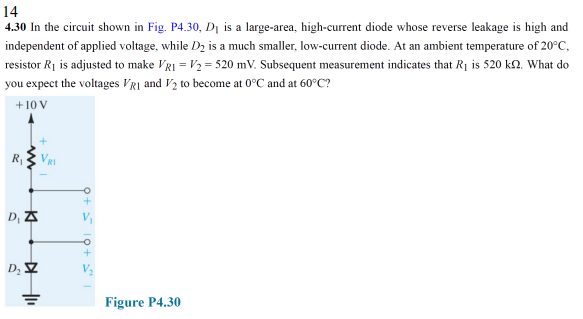Fig. P4.30, Dj is a large-area, high-current diode whose reverse leakage i ge, while D2 is a much smaller, low-current diode. At an ambient temperatun ke VR1 = V2 = 520 mV. Subsequent measurement indicates that R1 is 520 kl.
Fig. P4.30, Dj is a large-area, high-current diode whose reverse leakage i ge, while D2 is a much smaller, low-current diode. At an ambient temperatun ke VR1 = V2 = 520 mV. Subsequent measurement indicates that R1 is 520 kl.
Introductory Circuit Analysis (13th Edition)
13th Edition
ISBN:9780133923605
Author:Robert L. Boylestad
Publisher:Robert L. Boylestad
Chapter1: Introduction
Section: Chapter Questions
Problem 1P: Visit your local library (at school or home) and describe the extent to which it provides literature...
Related questions
Question

Transcribed Image Text:14
4.30 In the circuit shown in Fig. P4.30, D is a large-area, high-current diode whose reverse leakage is high and
independent of applied voltage, while D2 is a much smaller, low-current diode. At an ambient temperature of 20°C,
resistor R1 is adjusted to make VRI = V2 = 520 mV. Subsequent measurement indicates that R1 is 520 k. What do
you expect the voltages VRI and V2 to become at 0°C and at 60°C?
+10 V
R
VRI
D,
D, SZ
Figure P4.30
Expert Solution
Step 1
GIVEN,
VR1=V2=520mV
R1=520kohm
The voltage across the resistance is,
VR1=520mV= IR1=520X10-3
Put the value of R1,
I(520X103)=520X10-3
I= 10-6A
=1A
The reverse-biased diode, the diode current is equal to the saturation current.
I=IS=1A
The reverse voltage across the diode D1 is,
V1=10-(VR1+V2)
=10-0.52-0.52=8.96V
As the reverse current doubles for every rise in temperature , the reverse current at is,
IS() = IS/4= 1/4=0.25A
Calculate the voltage across the resistance, VR1
VR1=R1IS
=(520x103)(0.25x10-6)
=0.13V
=130mV
Trending now
This is a popular solution!
Step by step
Solved in 2 steps

Knowledge Booster
Learn more about
Need a deep-dive on the concept behind this application? Look no further. Learn more about this topic, electrical-engineering and related others by exploring similar questions and additional content below.Recommended textbooks for you

Introductory Circuit Analysis (13th Edition)
Electrical Engineering
ISBN:
9780133923605
Author:
Robert L. Boylestad
Publisher:
PEARSON

Delmar's Standard Textbook Of Electricity
Electrical Engineering
ISBN:
9781337900348
Author:
Stephen L. Herman
Publisher:
Cengage Learning

Programmable Logic Controllers
Electrical Engineering
ISBN:
9780073373843
Author:
Frank D. Petruzella
Publisher:
McGraw-Hill Education

Introductory Circuit Analysis (13th Edition)
Electrical Engineering
ISBN:
9780133923605
Author:
Robert L. Boylestad
Publisher:
PEARSON

Delmar's Standard Textbook Of Electricity
Electrical Engineering
ISBN:
9781337900348
Author:
Stephen L. Herman
Publisher:
Cengage Learning

Programmable Logic Controllers
Electrical Engineering
ISBN:
9780073373843
Author:
Frank D. Petruzella
Publisher:
McGraw-Hill Education

Fundamentals of Electric Circuits
Electrical Engineering
ISBN:
9780078028229
Author:
Charles K Alexander, Matthew Sadiku
Publisher:
McGraw-Hill Education

Electric Circuits. (11th Edition)
Electrical Engineering
ISBN:
9780134746968
Author:
James W. Nilsson, Susan Riedel
Publisher:
PEARSON

Engineering Electromagnetics
Electrical Engineering
ISBN:
9780078028151
Author:
Hayt, William H. (william Hart), Jr, BUCK, John A.
Publisher:
Mcgraw-hill Education,